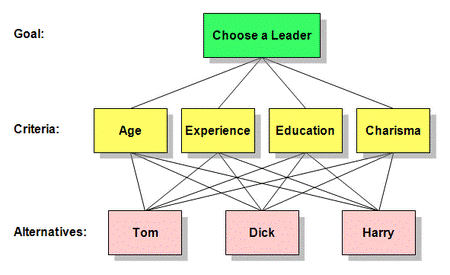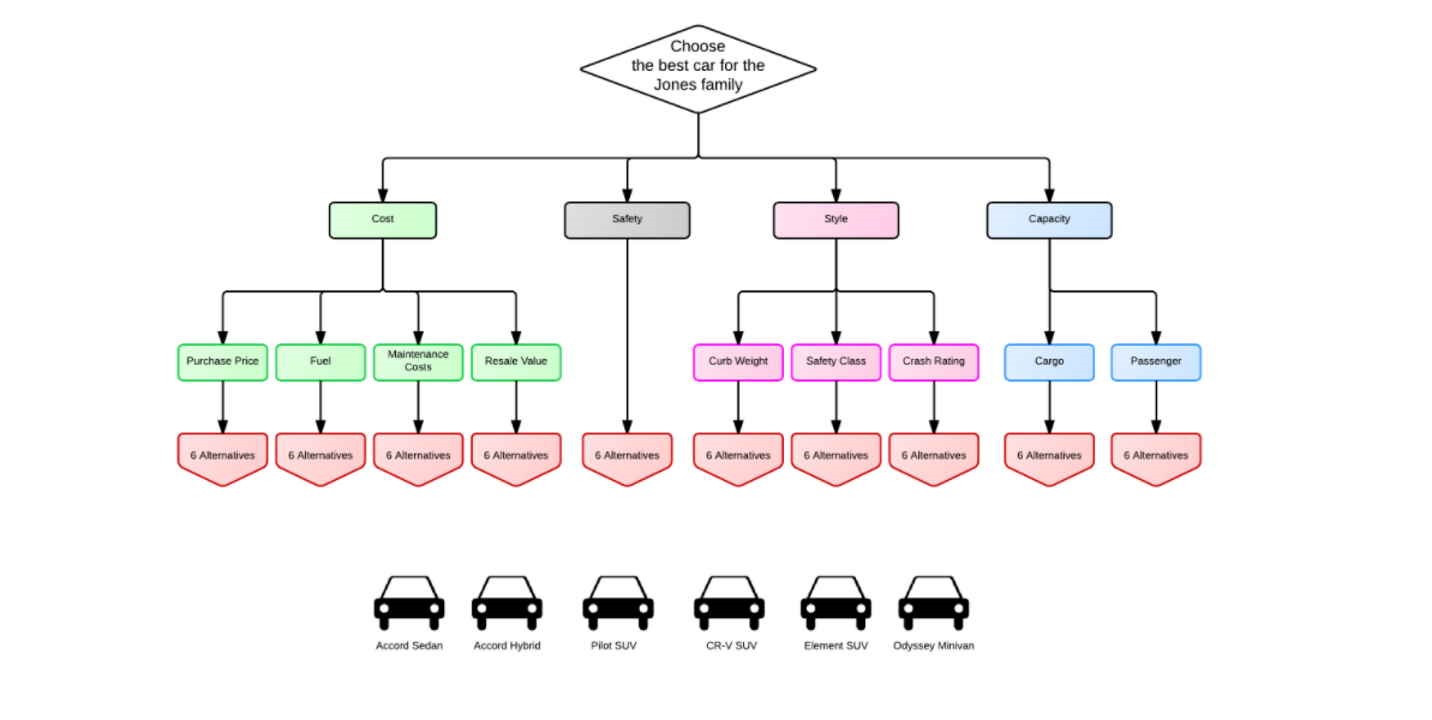What is AHP and how to use it?
The analytic hierarchy process is in fact one of the most common methods for decision-making. When a complex needs to make decisions with proper data and in a short time, it must use a scientific and professional process. Please stay with us for more information about the issue.
What is the analytic hierarchy process?
What is the analytic hierarchy process and how to use it? Do you know what the AHP is? Generally, everyone confronts various problems in his life that needs decision-making and choosing an option effective on the final result. Now, this decision can be a simple one like drinking coffee or tea or can be an important one like deciding to choose a location for a building. Of course, simple decisions have no effects on the decision-maker in the long term, but the critical in big decisions can lead to big consequences.
The people active in the management field are certainly familiar with the analytic hierarchy process. This method is raised when there are many options for decision-makers, but, there is no precise tool for evaluating the most correct decision. The AHP method is used in such conditions.
Maybe, most of the critical organizations choose one option among various options preferably. But, does this work lead to the expected need?
When you do not use any decision-making method and select an option yourself, the possibility of conflict will increase and many questions will bring into the mind like: is the desired option correct? Does this criterion get me to the main objective? To what extent will my decisions be effective on the result?
How is the performance of the analytic hierarchy process?
The Analytical Hierarchy process is known as the AHP method. But, what does the AHP mean, what are its applications, and can this method give us a specific process? About the first question, it has to be said that the pdf hierarchy process is in fact, one of the most useful methods for decision-making. When a complex needs to make correct decisions with little data and in a short time, it is forced to use a specialized and scientific method. Sometimes, some people make rational and correct decisions in the shortest possible time using comprehensive data like news or having high processing speeds and get satisfactory results. But, this decision-making method cannot be generalized to all problems.
In some cases, some projects have many options for an operation like building a playground in some different areas. In such conditions, if the decision is made without any helpful data, it might lead to high losses for the complex and the calculations will make irreparable losses. Of course, you may have this question that what is the solution in this condition, and what is the right way to make a decision?
In this condition, only correct calculations can result in the correct decisions. Nowadays, the most common method for decision-making can make it easy for you to use correct analysis. In big businesses, the right decision-making methods based on computerized calculations or decision-making algorithms are the most efficient, and understanding the analytic hierarchy process is one of the most efficient methods for decision-making.

The history of the analytic hierarchy process
Do you know what the AHP is? The history of the analytic hierarchy process goes back to the time that Iraqi Thomas L. Saaty was looking for a way to minimize the decision-making problems. When people are confused between the various competitor and criterion options they can choose the right option using the training with the analytic hierarchy process. Finally, in 1970, Saaty developed the most famous multi-purpose decision-making technique or the AHP.
Since everybody confronts rational limitations while making decisions and might not be able to make a comprehensive, rational, and regular decision, group participation is the only available method. Of course, you know that the businesses get more complicated each day and reach the more complicated technologies and as a result, their management gets changed and only one person cannot take full control of affairs alone. All these factors cause group decision-making to increase. But, in this way, some problems may occur like lack of integration and consistency, reproach, etc. so the manager inevitably uses various methods like brainstorming, Delphi method, and nominal group technique to reduce the decision-making problems. Maybe these methods are effective to some extent but, it is not useful in modern big organizations and practically, there is a need for a more comprehensive system. This hierarchy and the problems of human interference made Thomas use the ppt analytic hierarchy process.
When you are faced with different qualitative and quantitative criteria in a big organization, you can make decisions based on the pairwise comparison.
There are various papers published each year about the AHP that are published in the international journal of analytic hierarchy process. The international journal of the analytic hierarchy process (IJAHP) is a scientific journal that publishes papers related to researches and applications of the analytic hierarchy process and analytic network process.
What is the AHP method?
The decision-maker can be the manager or any other person that at first, start their work providing the hierarchy tree in the analytic hierarchy process (AHP). This tree includes the decision hierarchy, the compared factors, the competitor, and similar items that execute a series of pairwise comparisons on each parameter and after performing these comparisons, each criterion takes a specified weight and finally, the correct decision is made using the AHP method and with data adaption.
When Thomas proposed this decision-making method, at first, it was used for individual decision-making. After being satisfied with this method, it was used for group decision-making in the ’80s. When the use of this method in group decision-making became common, its many benefits surprised the businesses, and then the disadvantages of group partnerships were gradually eliminated.
The advantages of the analytic hierarchy process
The step-by-step analytic hierarchy process is effective in every decision-making. What is the training of the analytic hierarchy process? It is performed in the decision-making according to the existing criteria and parameters. Since this method is flexible and excellent in multi-criteria decision-making, so it can easily solve complicated problems. Each problem presented in the international journal of analytic hierarchy process has a series of aspects. The analysts organize these aspects in the format of a hierarchy.
Nevertheless, some of the advantages that are obtained using the ppt analytic hierarchy process are as follows:
If some people have expressed their opinion as to the decision-makers, this tool will check the consistency of the expressed opinions.
Using the pairwise comparison, it tries to use the best approaches and select the best option.
This method can consider all the criteria and sub-criteria and use them for evaluating the options.
After evaluating the existing criteria using pairwise comparison, the pdf AHP is capable of reaching the best option.
Understanding the pdf analytic hierarchy process is easy and when the decision-maker cannot reach stability in decision-making, he will use this method. The advantage of this method is that it organizes all the tangible and invisible parameters in a complex and finally, presents an approach that has a relatively simple and comprehensible structure.
The basis of this method is that when it is used for big and complicated problems, it converts these issues to some smaller issues and after the breakdown of the problem, relates the smaller issues to the big one using the pairwise comparison and this process will result in decisions based on science and scientific principles.
What are the principles of the analytic hierarchy process?
After getting familiar with the concept of the analytic hierarchy process or AHP, you have to know that each technique needs some principle for execution that should be met. These principles are:
- The reversibility:
To understand this principle, it is better to say that if we have several criteria in a problem, we shouldn’t neglect the analytic hierarchy process python and consider it in the pairwise comparisons. For example, when criterion C1 takes precedence in the order of “n” over criterion C2, therefore, criterion C2 takes precedence in the order of “1/n” over criterion C1.
- The homogeneity principle:
When you have several options about a problem, the options should be comparable to some extent and be of similar importance. When a parameter is stronger than the other, it certainly cannot be considered in the decision-making model.
- Dependence
When you start to organize the hierarchy, you have to consider that all the levels of the hierarchy tree to be dependent on each other and prevent entering inconsistent parameters.
- Expectancy:
Sometimes a parameter may be added during the process. The addition of the new parameter will change the structure of the system and as a result, the hierarchy model should completely change.

The analytic hierarchy process software
Generally, the analytic hierarchy process software is divided into online and offline groups. The offline software has to be installed and run on any operating system (windows, mac, etc.). From the disadvantages of the offline software, their high price could be mentioned. The online software does not need installation and is cheap and does not need an operating system. The outputs of the software are usually pdf, Word, text, or HTML files, which include the rate of inconsistency, weight, and ranking. In most of the software, there is a tutorial that can be in the pdf, ppt, or doc format.
Like other software, the AHP software can be coded with various programming languages like python, C#, PHP, etc.
An example of the analytic hierarchy process
Since the applications of the analytic hierarchy process (AHP) are very wide and have many areas, therefore, it is necessary to explain the analytic hierarchy process more simply using an example and make its perception easier.
Assume that you have some specified options and measures for evaluating a problem. Now, in this example, we specify the measures with the letter “M” and the options with the letter “N”. The effective steps in this method include the following items:
In the beginning, the measures are determined.
- Pairwise comparison of each two competitions: n*(n-1)/2 comparisons for each measure and creating the n*n matrix. The competitive can evaluate the options of a number in a specified space in terms of superiority.
- For example, when it is about to compare a confronted element and you have two “i” and “j” plans and the plan “i” is better than the plan “h”, then we assign the number 5 to the aij element and so aij = 5.
- We have to calculate the weight of each competition for the measures. To determine these weights, it is better to perform a series of row and column processes on the n*n matrix in the previous step and then, use the eigenvector method so the vector to be obtained with a specified “i” element. In this vector, the sum of the elements is equal to one and the value of the “i” is equal to the ith weight of the measures competitive.
- In the fourth step, repeat the previous steps and the reason for this work is to obtain an m*n matrix.
- Comparing the parameters and elements of the measures to obtain the weight of these measures and finally, introducing a better measure.

common applications of the AHP?
Since the analytic hierarchy process (AHP) is utilized for obtaining the superior parameter and this parameter should be selected from various options, therefore, this method has vast applications in organizations management and executive projects area.
From the obvious specifications of this method, simplicity, flexibility, and simultaneous use of qualitative and quantitative criteria, and also compatibility in judgments could be mentioned that this has resulted in the increased expectations from this analysis.
For example, it has various applications in urban positioning; various industries, factories, waste disposal, urban bazaars positioning, positioning new cities and selecting the location of new capital, etc. In addition, this process is used for connecting the plans and strategic planning and finally, it is used in the concept of spatial development and physics.
Besides the mentioned items, some of the most prominent uses of this method are AHP examples presented below.
As mentioned before, the excellent flexibility of this method has created a diverse application for it such that it is accompanied by various and complicated applications in the real world.
The evaluation of the city and planning: in this case, when it is intended to investigate several specified cities in terms of residence, the cities can be classified in terms of parameters like environment, residence, services, etc. Then, the criteria that have less importance like transportation facilities, etc. will be compared them more important factors like security will be compared and finally, according to these comparisons, the habitable environment will be selected.
Ranking the countries: In the late ’80s and early ’90s, the ranking of the countries was performed according to the JDP criterion. The analytic hierarchy process would use different factors for ranking the countries in 1980 and after studying the specifications, it would present the top countries.
The mobile cellphone services: one of the most important reasons that have increased the popularity of the analytic hierarchy process in mobile cellphones are the items like payment method, performance, value-added, quality, and expenses that using them the most popular brands that have high quality can be identified.
Organ donation: since the number of people in need of organ donation is increasing each year, therefore, proportionality should be established between the donors and receivers with combined optimization so the people in need of donation could be identified faster and get the required organ. The analytic hierarchy process (AHP) can be used to estimate the donors and needful people using the analysis of four parameters of speed, performance, benefit, and equality. For example, when two patients exist for an organ donation, this method determines In which case is life expectancy lower and in which person is it higher using precise calculations and after that, the patient with lower life expectancy is selected for the organ transplant.
